Physical Address
304 North Cardinal St.
Dorchester Center, MA 02124
Cholestasis is defined as a pathologic state of reduced bile formation or flow. Most cholestatic conditions can be classified as either obstructive or hepatocellular in origin and result in the retention of substances normally excreted into the bile, such as bilirubin, bile acids, or cholesterol, with consequent cell injury. Obstructive cholestasis results from an anatomic or functional obstruction of the biliary system. This can be at the level of the large or extrahepatic bile ducts (i.e., biliary atresia or cholelithiasis) or smaller intrahepatic ducts (i.e., bile duct paucity associated with Alagille syndrome [ALGS]). Hepatocellular cholestasis results from impairment of mechanisms of bile formation and implies defective function of most or all hepatocytes. This chapter discusses the most common cholestatic diseases that have a defined genetic etiology. The function and distribution of the specific genes involved in any of these conditions will dictate whether a defect in the gene results in an isolated cholestatic liver disease (i.e., progressive familial intrahepatic cholestasis type 3 [PFIC-3]) or a systemic disease (i.e., cystic fibrosis [CF] or ALGS). The diseases are categorized mechanistically according to whether their associated genetic defect affects bile formation or flow. , Using the information from Chapter 3 regarding bile acid physiology as a background, the various necessary components of bile production may be divided into the following: (1) bile acid production, (2) hepatocellular transporters that facilitate bile flow, and (3) membrane integrity including tight junctions, vesicular trafficking, and organelles that participate in bile flow. In most clinical forms of hepatocellular cholestasis, the molecular mechanism is a result of impaired bile flow secondary to a defect in membrane transport, embryogenesis, mitochondrial function, or bile acid biosynthesis ( Table 70.1 ). Recent advances in next-generation sequencing technologies have been instrumental in clarifying the role of defects in numerous genes involved in bile production and excretion in the etiology of pediatric cholestatic diseases. Many of these genetic defects have been found to be associated with separate and distinct liver-related symptoms in adult patients, such as benign recurrent cholestasis and intrahepatic cholestasis of pregnancy. Many of these will be discussed here.
| Defect in | Cholestatic Disease |
|---|---|
| Membrane transport | Progressive familial intrahepatic cholestasis Benign recurrent intrahepatic cholestasis Cystic fibrosis ARC syndrome NISCH syndrome |
| Embryogenesis | Alagille syndrome |
| Bile acid biosynthesis | Disorders of bile acid synthesis |
| Mitochondrial function | Mitochondrial hepatopathy Navajo, GRACILE α1-Antitrypsin deficiency |
Bile acid synthetic defect (BAD) diseases constitute the first general category of genetic cholestatic diseases in which the mechanism is impairment in bile acid production. The bile acids are produced in the hepatocyte and drive more than 60% of bile flow. They are synthesized from cholesterol by 14 enzymatic steps, all of which are coded for by a specific gene. There are seven known gene defects in this pathway, which are described in Chapter 3 . These diseases cause hepatocellular cholestasis due to toxicity of retained abnormal bile acid intermediates and low production of normal bile acids with resultant insufficient bile flow for normal function. Progressive liver damage is then inevitable. Clinical presentation varies among the seven disorders; however, jaundice, cholestasis, elevated transaminases, fat-soluble vitamin deficiency associated with low γ-glutamyl transferase (GGT), and low serum bile acids are the hallmarks of the disease. Diagnosis of BAD is made by testing the urine for normal and abnormal bile acid species with use of fast atom bombardment spectroscopy (FABS), which can identify the “fingerprint” of the inborn error by the pattern of bile acids present.
The normal mechanisms of bile formation are described in Chapter 3 . Specifically, bile formation is dependent on the interaction of the bile acid transporters and solute carrier systems on the basolateral membrane of the hepatocyte and the mostly ATP-dependent transporters (ABC transporters) located on the canalicular membrane ( Fig. 70.1 ). Bile flow begins at the basolateral membrane with uptake and exchange of solute from the portal blood, which does not require active transport. The basolateral transporters include the superfamily of organic ion transport proteins, which allow organic anion uptake in exchange for bicarbonate or glutathione. The sodium-dependent taurocholate cotransporter (NTCP) transports only bile acids coupled with sodium. The multidrug resistance-associated proteins—MRP3 7 and MRP4(Abcc4)—function as basolateral efflux pumps and are upregulated under cholestatic conditions to export bilirubin conjugates (by the former) and bile acids and glutathione (by the latter). There are no described genetic disorders of cholestasis related to basolateral membrane transporters.
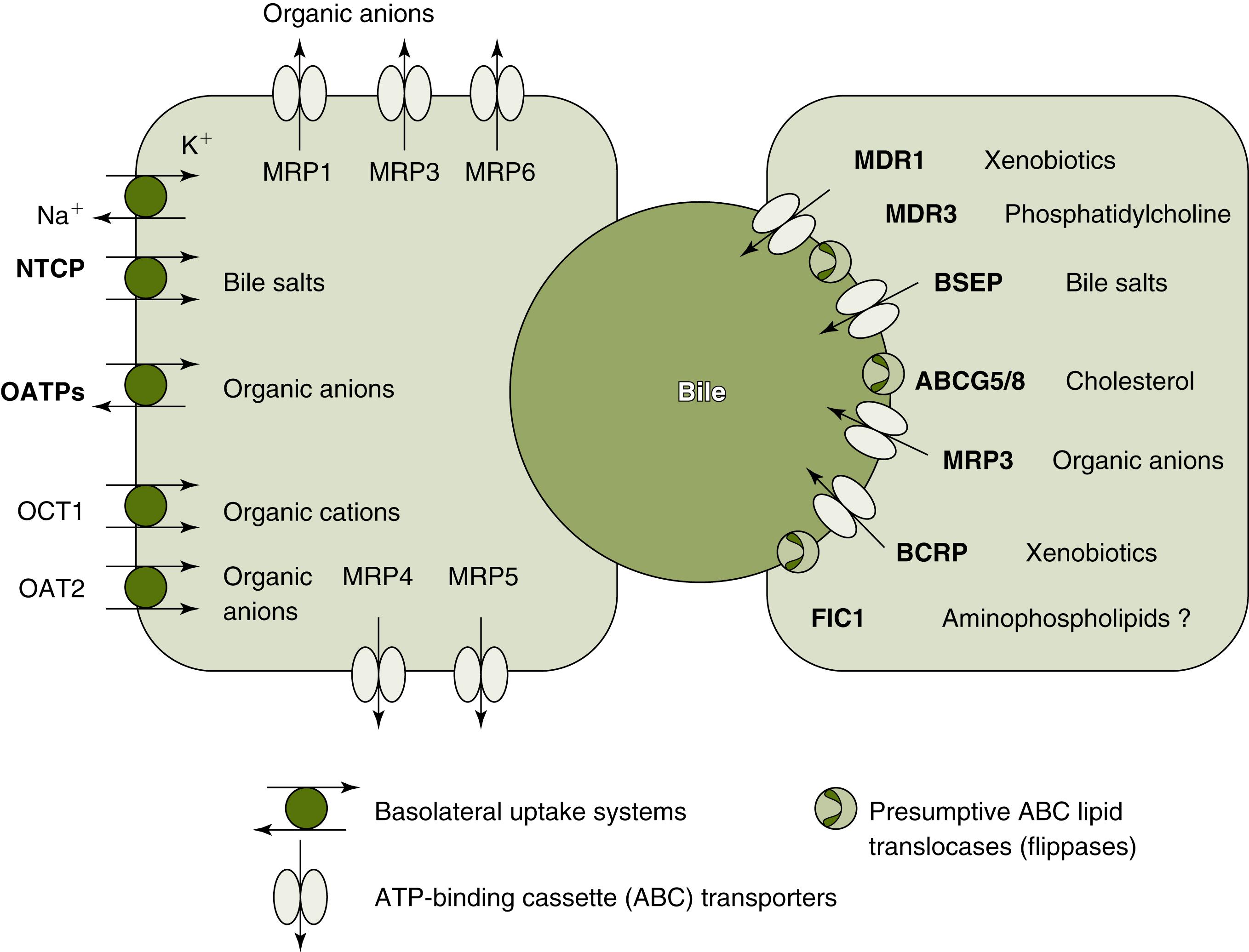
The canalicular membrane transporters reside in the canalicular membrane, which is rich in cholesterol and sphingomyelin (see Fig. 70.1 ). This membrane is very metabolically active, containing many ATP-dependent solute transport proteins. It also houses ion and water exchangers, vesicle fusion proteins (i.e., soluble N -ethylmaleimide-sensitive-factor [NSF] attachment protein [SNAP] or NSF attachment protein receptor [SNARE]), skeletal proteins (i.e., villin), and tight-junction proteins. Of particular importance as membrane transporters are FIC1 ( ATP8B1 ), which is an aminophospholipid translocase; the bile salt export pump (BSEP) ( ABCB11 ), which mediates conjugated bile acid transport; and the multidrug-resistant protein MDR3 ( ABCB4 ), a flippase of phosphatidylcholine. Defects in each of these transporters have been linked to inherited cholestatic diseases that were commonly identified as PFIC types I, II, and III, respectively ( Table 70.2 ). The three other forms of PFIC ( TJP2, NR1H4, and MY05B ) are not specific canalicular transporter defects but are listed here for ease of grouping the conditions.
| Locus | Gene | Defect | GGT | |
|---|---|---|---|---|
| PFIC-1 BRIC-1 |
18q21-22 | ATP8B1/FIC1 | ATP-dependent amino-phospholipid transport | Normal |
| PFIC-2 BRIC-2 |
2q24 | ABCB11/BSEP | ATP-dependent bile-acid transport | Normal |
| PFIC-3 | 7q21 | ABCB4/MDR3 | ATP-dependent translocation of phosphatidylcholine | High |
| PFIC-4 | TJP2 | Tight junction protein | Normal | |
| PFIC-5 | NR1H4/FXR | Nuclear bile acid receptor | Normal | |
| PFIC-6 | MYO5B | Myosin5b | Normal |
Our understanding of the family of conditions that make up PFIC and the genotypic and phenotypic differences among them is the result of functional and genetic mapping studies that have identified the genes and their functions over the last 15 years. Initially PFIC was clinically identified by the presence of hepatocellular cholestasis, low serum levels of GGT activity, and autosomal recessive inheritance. PFIC has now been redefined into six separate and distinct diseases with their own specific gene defects and distinct clinical profiles. Each of these genes has a role in normal bile production and excretion (see Table 70.2 ).
PFIC has evolved from its origins as a constellation of symptoms seen in the Amish who were descended from a single ancestor, Jacob Byler, when it was labeled “Byler disease.” Subsequently, numerous phenotypically similar non-Amish patients were reported, and then the term Byler syndrome was used to describe these patients. Later, the term PFIC was applied to all Byler-like patients—however, the patients were sorted into two distinct subtypes: low-GGT PFIC (PFIC-1,2, 4, 5, and 6) and high-GGT PFIC (PFIC-3). It is now the custom to refer to these diseases by their gene defect, that is, PFIC-1 as FIC1 disease, or by the transporter defect (see Table 70.2 )— ATP8B1 (FIC1 ), ABCB11 (BSEP), ABCB4 (MDR3), TJP2, NR1H4, and MYO5B . , , Despite their genetic distinctness, there are many clinical similarities between the PFIC subtypes, especially between PFIC-1 and PFIC-2. PFIC is clinically characterized by chronic cholestasis that begins in early childhood and usually progresses to cirrhosis within the first decade of life. The average age at onset is 3 months, and the disease may progress rapidly and result in cirrhosis during infancy or be slowly progressive with minimal scarring well into the teenage years. Pruritus is the dominant feature of cholestasis in the majority of patients. The pruritus is often misdiagnosed as skin disease because of the intense itching, which is unexplained; liver disease is not considered because of the disproportionately low level of jaundice in this condition. Patients begin to present with generalized mutilation of skin, usually most severe on the extensor surfaces of the arms and legs and on the flanks of the back, due to the disabling pruritus, which does not usually respond to medical therapies.
Severe episodes of recurrent epistaxis, perennial asthma-like disease, and growth failure are common associated problems. PFIC patients are described as “stocky” because of a high prevalence of short stature (95% of patients have stature below the fifth percentile), with often normal weight for height. Without treatment, there is often delayed onset of puberty and sexual development. Intellectually, these patients are equal to their peers if their pruritus is treated. Without treatment, their scholastic achievement can be compromised by inability to focus or concentrate and loss of sleep due to constant pruritus. Complications of cholestasis such as fat-soluble vitamin deficiencies are prevalent in untreated patients and discussed elsewhere in the text. Most patients will develop hepatic fibrosis and eventually cirrhosis, which is associated with the findings of hepatomegaly and sometimes splenomegaly. Unlike other cholestatic disease such as ALGS, PFIC patients do not develop xanthomas. In a recent clinical study comparing the presentation and course of PFIC-1 and PFIC-2 patients, several key differences were noted, which included that PFIC-2 (BSEP) patients exhibited more severe hepatobiliary disease compared to PFIC-1 (FIC-1) patients, whereas PFIC-1 patients had greater evidence of extrahepatic disease with diarrhea, pancreatic disease, pneumonia, abnormal sweat tests, hearing impairment, and poor growth. Patients with PFIC-1 are more likely to have associated watery diarrhea, some of which is severe. This secretory diarrhea may persist after liver transplantation.
Hallmark laboratory findings in PFIC-1, -2, -4, -5, and -6 are low GGT and normal or near-normal serum cholesterol, but markedly elevated levels of serum bile acids. In contrast, the GGT in PFIC-3 is elevated. Other serum values of liver-related enzymes such as alkaline phosphatase, aminotransferases, bilirubin, and bile salts are not distinct from those seen in several other cholestatic disorders.
The histopathologies of PFIC-1 and PFIC-2 are similar at the light microscopy level ( Figs. 70.2 and 70.3 ). Uniformly there is the presence of hepatocellular and canalicular cholestasis with pseudoacinar transformation consistent with cholate injury. The presence of multinucleated giant cell transformation is most commonly seen in infancy and has been recently reported to be more commonly seen in PFIC-2 (BSEP-deficiency) than PFIC-1 (FIC-1 deficiency). Degeneration of bile ducts may be seen with apoptotic changes of the biliary epithelium consisting of pyknotic nuclei (small and hyperchromatic) and attenuated cytoplasm and loss of duct lumina. Inflammation is absent. Bile duct paucity develops in 70% of older children because of these changes. In advanced fibrosis, there may be bile ductules at the edge of the portal tract. Lacy lobular fibrosis typically develops early and progresses to portal to central bridging and eventually to cirrhosis (see Figs. 70.2 and 70.3 ). The rate of progression of the fibrosis is highly variable but correlates loosely with the severity of the clinical disease. The major distinguishing histologic finding is seen at the level of electron microscopy with the presence of coarse granular bile in canalicular spaces of PFIC-1 patients, labeled “Byler bile.” PFIC-2 patients have a more filamentous morphology than the bile seen in the canalicular spaces. PFIC-2 (BSEP disease) has been associated with multiple cases of gallstones and hepatocellular carcinoma.
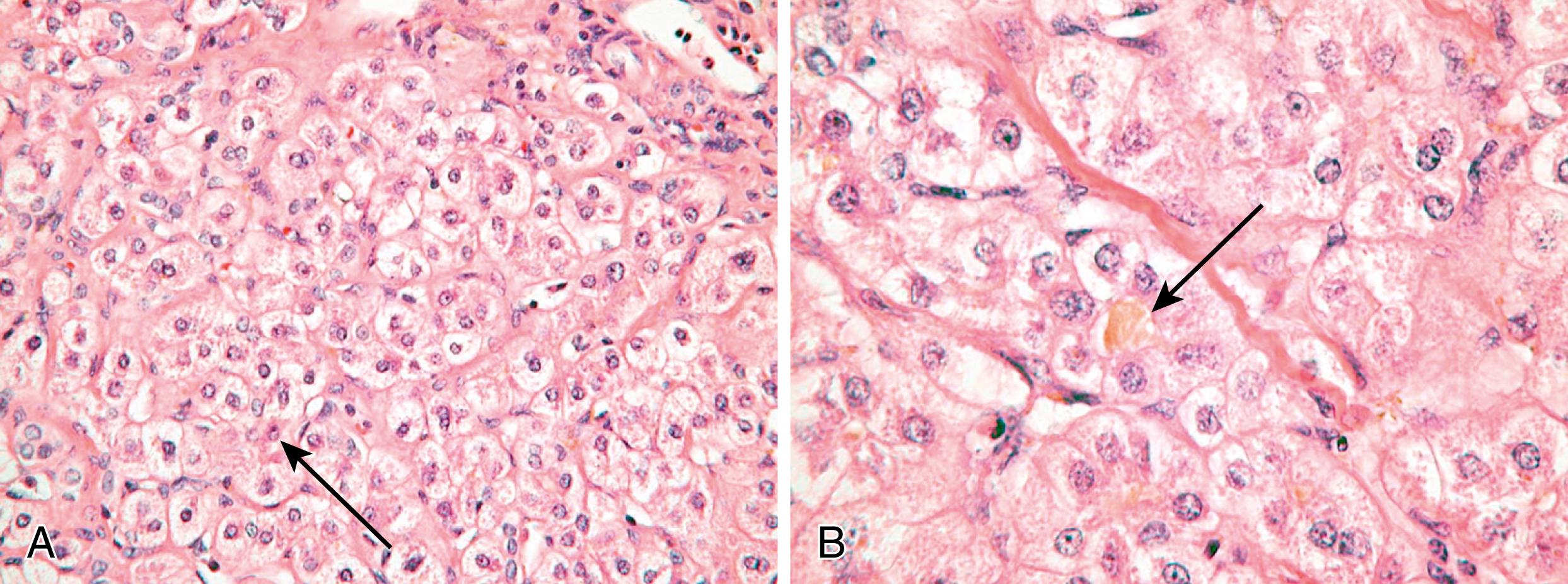
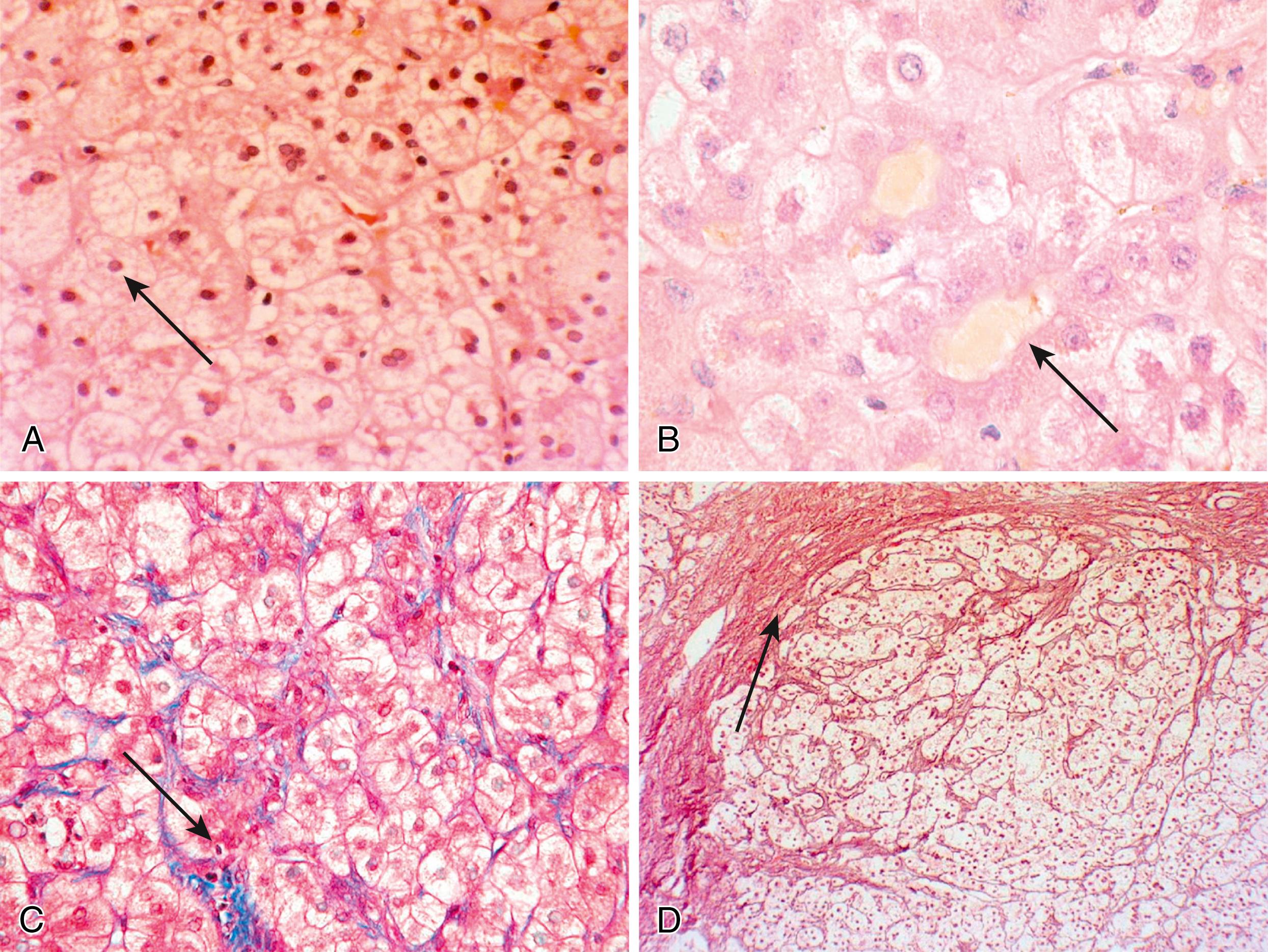
In PFIC-1 and PFIC-2, there is also an abnormal distribution both quantitatively and qualitatively of bile acids in serum and bile. Total serum bile acid concentrations are markedly elevated (usually greater than 200 μmol/L, normal less than 10) with an elevated ratio of chenodeoxycholic acid to cholic acid conjugates, usually greater than 10:1. The total biliary bile acid concentrations are low (0.1 to 0.3 mmol/L, normal above 20) even in comparison to other cholestatic syndromes such as ALGS, with a predominance of cholic acid conjugates.
As indicated by its name, PFIC is a progressive disease that culminates in cirrhosis and end-stage liver disease in the majority of patients. Medical treatment has consisted of the usual supportive care of cholestatic disease with fat-soluble vitamin supplementation and the use of ursodeoxycholic acid (ursodiol, 20 to 30 mg/kg/day). Although there is evidence that ursodiol may enhance bile flow, there is no evidence that it alters disease progression overall.
Surgical therapy consisting of the partial external biliary diversion (PEBD) has been used for the last two decades to treat PFIC and ALGS. PEBD involves the surgical placement of an enteric conduit between the gallbladder and the skin through which bile flow is partially diverted away from the enterohepatic circulation. It typically results in an approximately 50% diversion of bile flow, which amounts to ∼30 to 120 mL of bile per day that drains into the ostomy bag and is discarded. PEBD has been effective in improving chronic cholestasis and its associated complications in both ALGS and PFIC. , PEBD has become a standard intervention for PFIC and can slow or halt the progression of liver disease in this condition, which usually progresses to cirrhosis and end-stage liver disease if untreated. , After diversion, the bile salt pool converts to predominantly cholic acid conjugates, which has been associated with histologic and clinical improvement of the liver disease. PEBD may not always affect the natural progression of either ALGS or PFIC, and at present, no clinical parameters have been defined that predict patients who are likely to respond to biliary diversion procedure. Although PEBD has been shown in some cases to halt or reverse disease progression, it is generally ineffective in patients with established cirrhosis. Rare patients develop “watery” bile output after PEBD, with severe electrolyte losses that need to be monitored and replaced. Twenty years of experience with PEBD and PFIC has demonstrated variable relief of pruritus, improvement in liver histology, improved growth, and improvement in bile acid content of bile. , , , A variation of PEBD is the limited ileal diversion, in which the distal 20% to 25% of the ileum is removed from the intestinal mainstream and made into a self-emptying blind loop, which results in loss of bile salts similar to PEBD. Ileal diversion was originally reserved for patients who have had a cholecystectomy, as it tends to become less effective over time. In some cases, PEBD or ileal diversion does not significantly affect the progression to cirrhosis, and liver transplantation becomes necessary. , , ,
The gene for PFIC-1 (Byler disease), FIC-1 , has been mapped to a 19 cM region of 18q21-q22 by the detection of a preserved haplotype in affected members of the Byler pedigree. FIC-1 codes for an ATP-binding cassette (ABC), which is an aminophospholipid translocase that flips phosphatidylserine and phosphatidylethanolamine from the outer to the inner layer of the canalicular membrane.
The PFIC-2 gene is located at chromosome 2q24. , , It codes for an ABC bile salt transporter, also called the BSEP. The PFIC-2 gene is analogous to the rat sister gene of p-glycoprotein (S-PGP), which, in rats, has been shown to be important in bile salt transport. Studies of liver tissue from patients with mutation of BSEP have revealed lack of canalicular BSEP expression by immunohistochemistry ( Fig. 70.4 ). , This finding has clarified that PFIC-2 patients may have limited or no BSEP protein and therefore have a primary inability to transport bile salt.
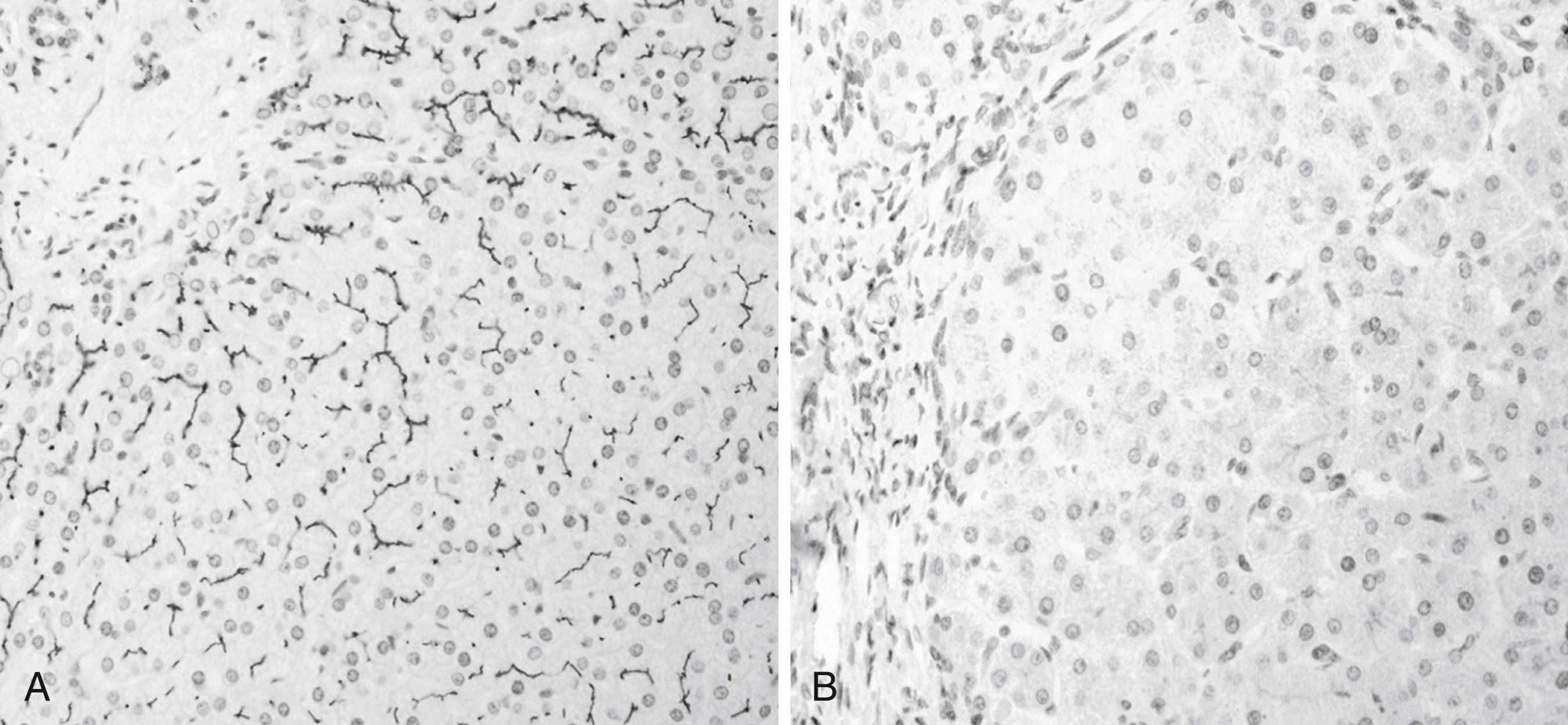
In 2014 a group of patients who had low GGT cholestasis tested negative for FIC1 and BSEP deficiency but were found to have mutations in the tight junction protein 2 gene. In this condition protein-truncating mutations in the tight junction protein 2 gene (TJP2) cause failure of protein localization and disruption of tight-junction structure, leading to severe cholestatic liver disease.
In 2016 two cholestatic kindreds, who tested negative for the gene defects listed above, were found to have mutations in the gene NR1H4 which caused deficiency in the farnesoid X receptor (FXR). , Three of the reported four patients with loss of FXR protein function due to mutations presented with cholestasis at less than 7 weeks of age, associated with normal GGT and severe coagulopathy. Additionally, two of the patients had elevated levels of Alpha-fetoprotein (AFP). There was undetectable immunohistochemical staining for BSEP and FXR in all four of the livers of the patients (FXR has a role in inducing BSEP). The three cholestatic patients progressed rapidly to end-stage liver disease as infants and two received transplants at < 22 months, while one died at 8 months old awaiting transplant.
FXR is a nuclear receptor and transcription factor that plays a role in bile acid homeostasis. Bile acids are a ligand for FXR. High bile acid levels in the hepatocytes cause downregulation of bile acid synthesis and uptake and increased excretion of bile acids out of the hepatocyte. Also, intestinal cells in the terminal ileum bind bile acids, which then activate FXR. FXR then causes expression of FGF19 which in turn will travel in the portal blood to the liver where it will suppress bile acid synthesis and regulate other genes of cholestasis such as ABCB11. , Based on these functions, loss of FXR function would result in cholestasis and liver injury.
It is believed that homozygous loss of FXR function due to NR1H4 mutations causes a low GGT form of severe PFIC. The clinical features of NR1H4 -related cholestasis include neonatal onset with rapid progression to end-stage liver disease, early onset vitamin K-independent coagulopathy, low-to-normal serum GGT, elevated serum alpha-fetoprotein, and undetectable liver BSEP expression. The lack of elevation of GGT is consistent with the loss of BSEP expression. BSEP, encoded by ABCB11 , was the first identified FXR target gene. The BSEP promoter is particularly responsive to FXR activation, suggesting that the absence of BSEP expression is a direct consequence of the loss of FXR function. Expression of MDR3, which is less responsive to FXR, was retained.
Myosin 5B (MYO5B) has been demonstrated to function in the polarization of epithelial cells, in plasma membrane recycling, and in the trafficking of ABC transporter proteins to the canalicular membrane via interaction with RAB11A. Patients with microvillus inclusion disease (MVID) were found to have mutations in MYO5B. Some patients with MVID also had cholestasis as part of their presentation. However, recently 15 patients with autosomal recessive MYO5B mutations presented with cholestasis but no features of MVID. These patients with isolated cholestasis typically presented by the age of 2 years with jaundice, pruritus, and hepatomegaly on exam. Their laboratory values included high serum bile acids and low GGT with variable transaminases. Liver tissue from these patients has shown hepatocellular and canalicular cholestasis and sometimes giant cell transformation. Immunohistochemical studies of the tissue show various patterns of abnormal staining of MYO5B, RAB11A, BSEP, and MDR3. These patients have been medically managed with ursodeoxycholic acid, cholestyramine, rifampicin, and antihistamines. In comparing the phenotypes of the various patients with -MVID/+cholestasis and +MVID MYO5B mutations, the patients with +MVID are more likely to have biallelic severe mutations which affect the MYO5B-RAB11A interaction. Thus the -MVID/+cholestasis patients may be a milder form of MYO5B dysfunction.
PFIC-3 is distinct from the previous five disorders primarily in that high serum GGT level is present. This condition shares the pattern of the first two disorders in that it is familial, recessive, and begins as intrahepatic cholestasis in the first year and progresses toward hepatic failure in the first few years of life. A major distinction, besides the high GGT, is the histopathology, which has more of an “obstructive” pattern. Liver biopsies show expanded portal areas with proliferation of interlobular bile ducts plugged with bile. Analysis of PFIC-3 bile revealed very low concentrations of phospholipids and led to investigations of the human analog of the Mdr-2 knockout mouse, which had a similar phenotype of no phospholipids in the bile and obstructive findings on liver biopsy. It was thereby discovered that PFIC-3 is caused by mutations in an export pump of the ABC transporter family called multidrug resistance 3 (MDR-3) that is expressed on the canalicular membrane. , It functions in the translocation of phosphatidylcholine across the canalicular membrane. Mdr-2–deficient mice made transgenic by expression of the human homolog of mdr-2, MDR-3, recover function and excrete phospholipid in their bile. This finding confirms the functional homology between the mouse and human genes and further suggests that phospholipid excretion is limited by the amount of MDR-3 or mdr-2 present. The MDR-3 gene has been mapped to 7q21. The absence of phospholipids in this condition is felt to destabilize the formation of micelles due to insufficient phospholipids to solubilize the cholesterol. The imbalanced micelles likely promote lithogenic bile with crystallized cholesterol, which could produce small bile duct obstruction.
There have been reports of several families with clinical and biochemical features consistent with PFIC who do not have mutations in FIC-1, BSEP, or MDR-3 . Therefore, there may be a wider spectrum of disease in PFIC yet to be described.
The condition benign recurrent intrahepatic cholestasis (BRIC) presents very similarly to PFIC, with cholestasis, pruritus, low GGT level, and high serum bile acid level; however, the hallmark of this condition is intermittent episodes of cholestasis without progression to liver failure and later onset than PFIC. , Patients are totally asymptomatic, both clinically and biochemically, in between the episodes of cholestasis. BRIC-1 and BRIC-2 share the same locus with PFIC-1 ( ATP8B1 mutation) and PFIC-2 [ ABCB11 (BSEP)] respectively, but the mutations cause only partially impaired protein synthesis (see Table 70.2 ). , , The cholestasis episodes have been treated by temporary biliary diversion using nasobiliary tube drainage of bile during the episode with some success in relieving the pruritus. However, in select cases, surgical biliary diversion has also been used for cases of BRIC with frequent debilitating attacks, or when there appears to be progression to permanent cholestasis. The clinically more severe disease identified as Greenland Eskimo infantile cholestasis is seemingly also a variant of FIC1 disease.
Aagenaes syndrome is identified as a genetic form of cholestasis associated with lymphedema that is mapped to chromosome 15q. It was initially reported in Norwegian patients; however, subsequently there have been reports in Italian children, in Japanese children, and in siblings with French/German heritage. The inheritance appears to be autosomal recessive. Studies are underway to identify the gene locus for this disease using linkage disequilibrium.
Clinically, jaundice in the first weeks of life with acholic stools may be the first manifestation of the disease. Overall, the cholestatic liver disease tends to improve with age such that bilirubin and aminotransferase levels may be normal by school age. Cholestasis occurs episodically in older children with cholestatic periods lasting 2 to 6 months. The liver disease tends to be mild in most patients, but several older children and adults have progressed to cirrhosis. Both puberty and pregnancy have been associated with transient increases in cholestasis.
The liver histopathology in early childhood shows massive giant cell transformation of hepatocytes and intracellular retention of bile pigment. Patients in clinical remission may have liver morphology close to normal. Some patients may have bile plugs and a slight increase in portal fibrosis. Four of 26 patients reported by Aagenaes et al. have developed biopsy-proven cirrhosis. Treatment is that of cholestasis, utilizing fat-soluble vitamin supplementation and choleretic agents. The lymphedema usually appears in the lower extremities in early childhood and has been attributed to lymphatic vessel hypoplasia. The greater clinical problem tends to be the lymphedema, which can become disabling. Patients are offered physical therapy and restrictive wraps to limit the fluid accumulation and prevent skin breakdown.
Arthrogryposis multiplex congenita, renal dysfunction, and cholestasis syndrome (ARC) is an autosomal recessive multisystemic disorder associated with the germline mutation VPS33B that is mapped to chromosome 15q26. In the largest study of ARC patients published to date involving 66 patients, the most prevalent clinical features described were failure to thrive, the presence of neonatal cholestasis with low GGT level, platelet dysfunction with high risk of hemorrhage with liver biopsy and spontaneous bleeding, renal tubular leak, and hypotonia with arthrogryposis. Less frequent clinical features include small for gestational age, dysmorphic features (lax skin, low-set ears, high arched palate, and cryptorchidism), ichthyosis, metabolic acidosis, nephrogenic diabetes insipidus, recurrent infections, recurrent febrile illnesses, and diarrhea. Survival beyond a year of age is unusual. If the patient survives infancy, cerebral manifestations including severe developmental delay, hypotonia, nerve deafness, poor feeding, microcephaly, and defects of the corpus callosum may become evident.
VPS33B is a vacuolar sorting protein involved in the regulation of vesicular membrane fusion and protein sorting by interacting with SNARE protein on membranes such as the canalicular membrane. Patients with ARC have evidence of abnormal polarized membrane protein trafficking by immunostaining of renal and liver biopsies that show mis-localization of several apical membrane proteins in the liver and kidney ( Fig. 70.5 ). In the zebrafish knockdown of the vps33b ortholog, bile duct paucity and impaired intestinal lipid absorption were observed. These findings phenocopied the digestive disease seen in ARC patients and suggest that VPS33B may play a role in primary bile duct development. VPS33B is also required for megakaryocyte and platelet alpha-granule biogenesis. Defects in platelets of patients with ARC have been documented and are associated with increased platelet size, a pale appearance in blood films, and a decrease or absence in alpha-granules. This defect causes platelet dysfunction that clinically has been manifested as increased incidence of bleeding with liver biopsy and spontaneous bleeding.
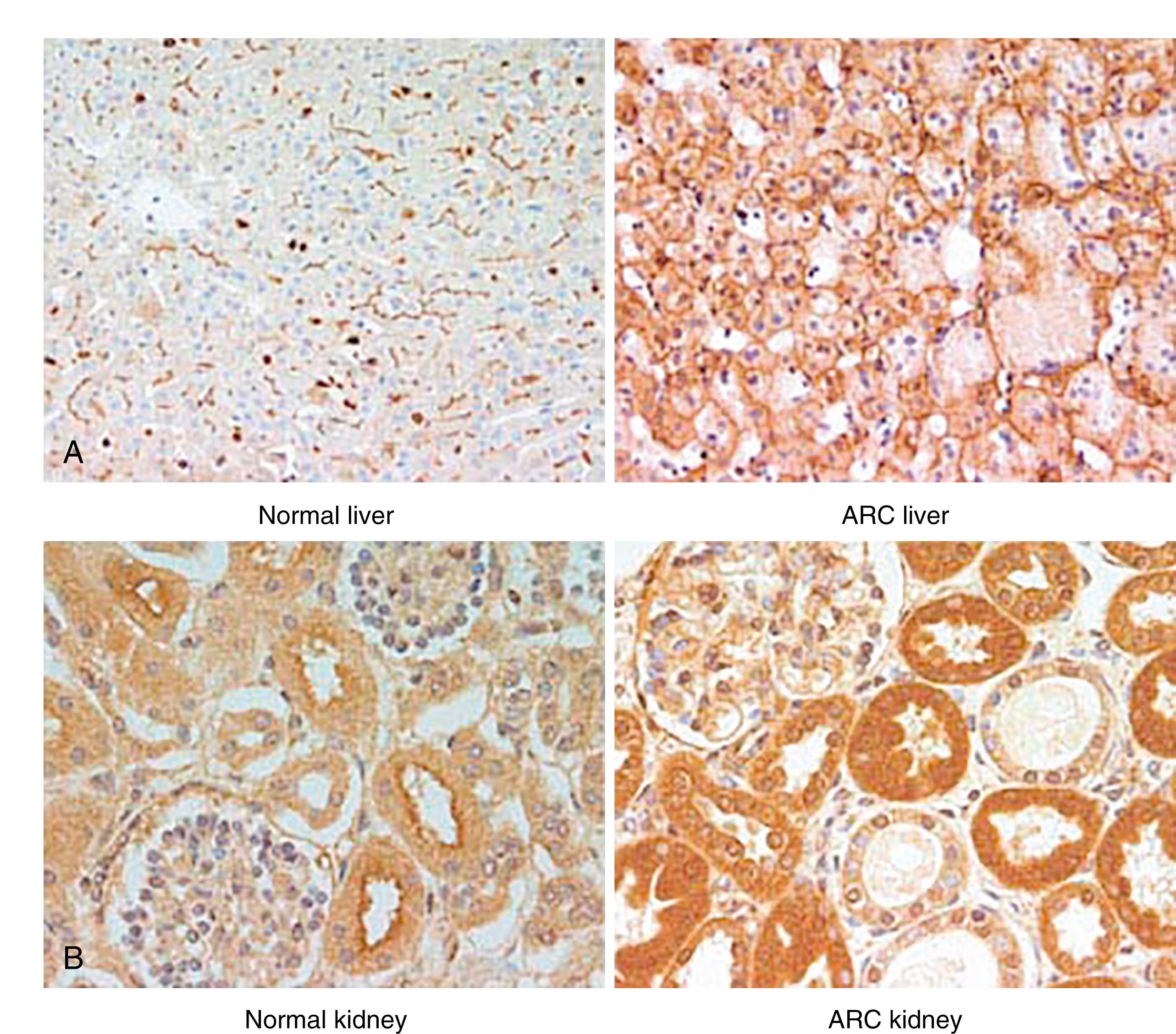
Severe cholestasis may occur in association with arthrogryposis multiplex congenita and renal disease. The cholestatic liver disease is usually present at birth, and paucity of intrahepatic bile ducts and multinucleate transformation of hepatocytes are the predominant features. Lipofuscin deposition has been described in several cases of ARC, and pigmentary change, bile duct paucity, and giant cell transformation may coexist in some patients. Patients with ARC rarely survive long enough to develop cirrhosis. Causes of death have been reported as infection, bleeding complications, or metabolic derangements.
Become a Clinical Tree membership for Full access and enjoy Unlimited articles
If you are a member. Log in here